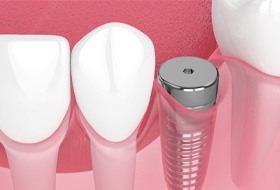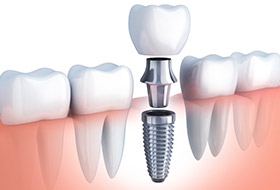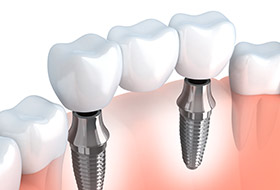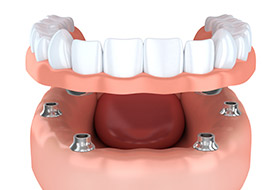Dental Implants – Wethersfield, CT
The Premier Way to Replace Missing Teeth
Whenever a patient comes to see us wanting to replace their missing teeth, our first recommendation is usually dental implants. Why? Because they are simply the best option for most people! They are the only treatment that restores an entire tooth both above and below the gum line, providing the most reliable, durable, and natural-looking result possible. If you’re hoping to get your complete smile back, dental implants can help you do exactly that, and they can do it better than anything else. To learn more about this treatment and what it could do for you, contact us today.
Why Choose Wethersfield Dental Group to Replace Missing Teeth?
- Highly skilled & experienced dentist
- Custom-made restorations for every patient
- Designed to last a lifetime
The 4-Step Dental Implant Process

Dental implants require a multi-step process that spans several months. This may seem like a long time, but it allows patients to experience long-term benefits that you can’t get from dental bridges and dentures. At Wethersfield Dental Group, we partner with a network of local specialists to perform this procedure. They have performed this surgical procedure thousands of times before, so we trust that they’ll give patients’ new smiles a strong foundation. After a patient has healed from the placement procedure, they’ll return to Wethersfield Dental Group to receive their permanent restorations. Here are the four main steps you can expect in the process of getting dental implants.
Initial Dental Implant Consultation

The first step when getting dental implants is to attend a consultation. During this time, we will take a look at your smile and go over your medical history to determine if you are a good candidate for the procedure. If needed, we will discuss preliminary treatments, like gum disease treatment, bone grafting, and tooth extractions. These types of treatments can help to make sure your dental implants are strong and healthy for many years down the road. During your consultation, we will also discuss the financial aspects of your treatment so there aren’t any surprises.
Dental Implant Surgery

We work with a local specialist to ensure that your dental implant placement procedure goes as smoothly as possible. First, the area will be numbed with a local anesthetic to make sure you are comfortable throughout the duration of the procedure. Then, an incision is made into the gum tissue so the implant posts can be placed. Lastly, the gums are closed, and protective caps are placed over the posts so they can heal over the next few months.
Dental Implant Osseointegration & Abutment Placement

Osseointegration is the fusion process that takes place between the titanium implant and your jawbone. This process is what makes your dental implant so stable in your mouth. When osseointegration is complete, metal abutments are placed on the end of the implants. Your final restoration will be crafted from impressions taken of your smile.
Delivery of Dental Implant Restorations

The last step is the delivery of your restoration. You will be called back to the practice so you can receive your crown, bridge, or denture. This will be placed on your implant(s) so you can walk out with a new, beautiful smile. During this visit, we will ensure that your bite lines up properly and everything feels comfortable.
Benefits of Dental Implants

These titanium posts come with a wide range of advantages for both your mouth and your overall well-being. During your consultation, we’ll discuss the benefits of dental implants so that you know what to expect from your treatment. Keep reading to learn several important ways this tooth replacement option can improve your oral health as well as your quality of life.
Day-to-Day Benefits

- Stability: A dental implant is a small titanium post that is placed directly into the jawbone to recreate the root structure of a lost tooth, and this can be used to support any number of restorations above the gum line. Since these new teeth are held in place by strong bones, patients don’t have to worry about them breaking or shifting no matter what they eat.
- Enhanced Biting Power: Unlike other restorations or prosthetics, dental implants can help you restore 80% or more of your natural chewing ability.
- Aesthetics:Unlike other tooth replacements, implants don’t have obvious metal attachments. They are also topped with porcelain restorations, helping them blend seamlessly into any smile. This means you’ll be free to show off your pearly whites without worrying about others noticing them.
- Simplified Maintenance: Dental implants will look and function just like natural teeth, meaning you can brush, floss, and rinse them like normal while also visiting your dentist biannually to maintain them.
Health Benefits

- Bone Retention:Implants reestablish important internal support for the jawbone. This helps prevent the bone loss that is so common after tooth loss, which preserves the overall shape and appearance of a patient’s face. No other treatment can do this!
- Greater Dental Health: Since dental implants can be cared for similarly to natural teeth, you’ll have a significantly reduced chance of developing problems like cavities, gum disease, or infection.
- Better Overall Health: By having improved oral health, you’ll be able to more easily avoid other complications that can affect the rest of your body, such as diabetes and heart disease.
Long-Term Benefits

- Longevity: With the proper care, a dental implant can be expected to last for around 30 years or even for the rest of a patient’s life in some cases.
- Successful Treatment: Not only can these titanium posts last decades to a lifetime, but they also have a success rate of over 95%, even 10 years after they’ve been placed.
- Cost-Effective Method: While this procedure does come with a higher upfront price compared to other options, like dentures and dental bridges, you won’t need replacements as often as the other treatments. Since they can also help you avoid oral health issues later on, they can end up saving you more down the road.
Indications for Dental Implants

Implants can be used to successfully reverse any degree of tooth loss, so no matter what your situation might be, implants can likely help. Dr. Phadnis can help you decide which of the following restorative options would be the best fit:
Missing One Tooth

Once an implant root is firmly in place, a single all-porcelain dental crown can be attached to it using a small connector called an abutment. This tooth won’t require the surrounding ones to be altered in any way, better preserving a patient’s natural smile.
Missing Multiple Teeth

Instead of replacing three or more missing teeth in a row with individual implants, just two implants can be used to support a strong and reliable bridge. Implant-retained bridges not only look better than traditional ones, but they can be trusted to last much longer as well.
Missing All of Your Teeth

To replace an entire row of teeth, we only need four dental implants, which we can use to anchor a denture to the jawbone. This will give it the hold and security a traditional removable prosthetic simply can’t match.
Understanding the Cost of Dental Implants

The final cost of a dental implant procedure can be quite different from patient to patient depending on their specific needs, such as how many teeth they would like to be replaced, where they are located in the mouth, and what kind of restoration they want. The need for any preparatory procedures in order to make a patient a good candidate for implants (such as a tooth extraction or bone graft) can add to the overall cost as well.
While implant restorations do tend to be more expensive than their traditional counterparts, they are actually the best long-term investment. Implants are able to last for decades longer than regular bridges and dentures, enabling a patient to save thousands in periodic maintenance and retreatment over time, not to mention countless hours spent in the dental chair!

